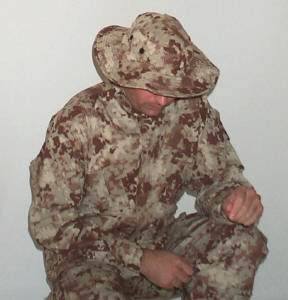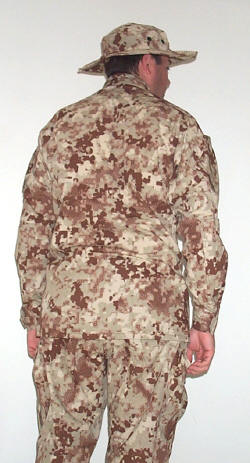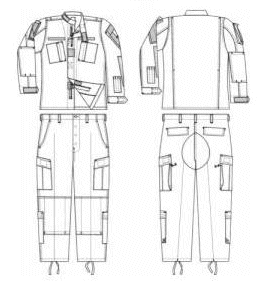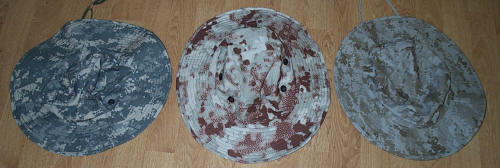
Desert Vipers in the Sand:
 |
|
SpecAm Desert Viper seen at dusk |
 (October
1, 2005, Vancouver, B.C.)
HyperStealth Biotechnology Corp. reveals the first authorized photos of the
SpecAm Desert Viper uniform.
The first photo disclosure from HyperStealth regarding SpecAm came in the Summer
with the Tropical specific color scheme (Link at end of article).
(October
1, 2005, Vancouver, B.C.)
HyperStealth Biotechnology Corp. reveals the first authorized photos of the
SpecAm Desert Viper uniform.
The first photo disclosure from HyperStealth regarding SpecAm came in the Summer
with the Tropical specific color scheme (Link at end of article).
SpecAm was designed for global operations so HyperStealth designed the pattern with the most common background noise found across this broad spectrum, given their only requirement was to make sure no true black was in any of the color schemes, they were able to design what should work and not what others thought it should look like.
While SpecAm was designed from natural leaf formations as a scalable fractal (feedback loop) to both blend and disrupt the user from the adversary, the transition to an acceptable desert camouflage was made by shifting the colors to allow for greater blending with the most common desert colors - among the three lightest layers which accounts for approximately 75% of the overall pattern. The 4th layer uses a common red/brown found in desert shadows and rocks. This red/brown is the disruptive element of the pattern designed to breakup the soldiers shape as the human brain can easily identify the shape of the human outline if the main colors don't blend in certain environments and there is inadequate disruption within the pattern. Examining a piece of camouflaged patterned fabric on the ground to check the effectiveness is very different than a person wearing the same pattern in the field at 75 yards distance.
 Desert colors
have a high range of variability: light tan / pink / grey / light green /
red and brown. The night element must also be taken into account as bright
desert colors in a uniform tend to shine at night - hence the desert night
pattern the U.S. came up with. The Kingdom of Jordan's KA2 patterns tend to be
a tad on the darker side - two reasons; the deserts are darker than most but
the pattern works extremely well at night. His Majesty, King Abdullah, given
his extensive military education and service is very in-tune with the fact
that many combat scenarios are done in the cover of darkness and your
camouflage should work under those conditions as well as the day time.
HyperStealth used this lesson from the King to design SpecAm Desert Viper as
the pattern lends itself to a darker desert camouflage than the current U.S.
Desert, the U.S. Army regular and reserve forces are now replacing their
current Desert pattern with ARPAT (Army Pattern) which will operate in all
theaters of operation as one color scheme.
Desert colors
have a high range of variability: light tan / pink / grey / light green /
red and brown. The night element must also be taken into account as bright
desert colors in a uniform tend to shine at night - hence the desert night
pattern the U.S. came up with. The Kingdom of Jordan's KA2 patterns tend to be
a tad on the darker side - two reasons; the deserts are darker than most but
the pattern works extremely well at night. His Majesty, King Abdullah, given
his extensive military education and service is very in-tune with the fact
that many combat scenarios are done in the cover of darkness and your
camouflage should work under those conditions as well as the day time.
HyperStealth used this lesson from the King to design SpecAm Desert Viper as
the pattern lends itself to a darker desert camouflage than the current U.S.
Desert, the U.S. Army regular and reserve forces are now replacing their
current Desert pattern with ARPAT (Army Pattern) which will operate in all
theaters of operation as one color scheme.The photos on this site are of the SpecAm Desert Viper color scheme (color differences are due to different lighting conditions).
 The uniform design is a warm weather
version of the ACU (Army Combat Uniform) without zippers:
The uniform design is a warm weather
version of the ACU (Army Combat Uniform) without zippers:
Why does the ACU use Velcro pocket closures, they're loud and tend to require dirt removal?
Many uniforms up until the late 1990's had outside buttons, MARPAT (U.S. Marines Pattern) uniform was modified with hidden buttons so they wouldn't snag on objects in the field. Velcro was used for the chest pockets. These pockets were placed on angles for easier access when wearing load bearing vests and/or flack vests which were now common in combat as buttons under the vest tended to dig into the body.
 |
|
ARPAT (Left) SpecAm Desert Viper (Middle) MARPAT Desert (Right) |
For the ACU with the addition of shoulder protection, leg holsters, packs, and extra harnesses for modern special operations it was decided to remove all buttons from pockets on the ACU except for the back pockets where they are concealed. Under combat conditions, soldiers with proper training have been able to maintain the Velcro so it continues to be clean. Zippers from the ACU (used for the same reason Velcro is used on the pocket closures) were replaced on the SpecAm with button fly and concealed button opening on the jacket as the zippers tend to jamb with sand, dirt and debris.
SpecAm Alpha series uniforms in this color scheme is now available to Pre-order from HyperStealth.
New Article August 17, 2005: Something Wicked This Way Comes: New Special Operations (SpecAm) Digital Camouflage
New Article September 3, 2005: The Science of SpecAm Digital Camouflage
Press Release September 14, 2005: NxGenUSA Acquires U.S. license for HyperStealth® SpecAm™
Press Release September 22, 2005: HyperStealth® Camouflage goes Biotechnical
New Article October 9, 2005: Satellite Determined - Regional Specific SpecAm™ Camouflage
New Article October 16, 2005: SpecAm HCD™ (High Contrast Disruption™) Woodland
New Article October 20, 2005: SpecAm UT™ (Urbanized Terrain)
New Article November 13, 2005: SpecAm Desert Jackal Camouflage
HyperStealth News November 24, 2005: SpecAm Production Announcement
For more Camouflage news go to the HyperStealth® Home Page
These patterns are copyrighted ©2004 HyperStealth Biotechnology Corp., All Rights Reserved. Patterns may be licensed only with permission.